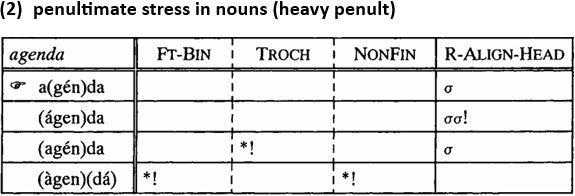


 Grammar
Grammar
 Tenses
Tenses
 Present
Present
 Past
Past
 Future
Future
 Parts Of Speech
Parts Of Speech
 Nouns
Nouns
 Verbs
Verbs
 Adverbs
Adverbs
 Adjectives
Adjectives
 Pronouns
Pronouns
 Pre Position
Pre Position
 Preposition by function
Preposition by function 
 Preposition by construction
Preposition by construction
 Conjunctions
Conjunctions
 Interjections
Interjections
 Grammar Rules
Grammar Rules
 Linguistics
Linguistics
 Semantics
Semantics
 Pragmatics
Pragmatics
 Reading Comprehension
Reading Comprehension|
Read More
Date: 15-1-2022
Date: 2024-02-02
Date: 2025-02-15
|
Stress assignment in English nouns: Pater's (1995) OT model
I will briefly outline the general constraint hierarchy responsible for the stress patterns in English nouns, omitting a number of constraints not directly relevant for the present purposes. The specific phonological properties of -ize verbs result from the operation of constraints that occupy a lexically specified position in the general hierarchy. This is in line with the idea frequently expressed in the literature (e.g. Alber 1998, Benua 1995, 1997, Urbanczyk 1995, 1996) that members of derivational categories are subject to the general prosodic constraints of a language, but that these categories involve further faithfulness relations which enrich the general constraint hierarchy of the language. As we will see, such constraints do not only influence stress assignment, but also segmental stem alternations as those that can be observed with -ize derivatives.
The following of Pater's constraints are most important for the analysis of -ize verbs. They are also the ones that are highest in Pater's hierarchy. The constraints and their definitions are given in (1a), their hierarchical ordering is given in (1b):
(1) 
Basically, it is these four constraints that are responsible for the well-known generalization that English nouns are stressed on the penultima if it is heavy, and on the antepenultimate syllable if the penultima is light, (e.g Giegerich 1992:187, Burzio 1994:43). Let us see how this works. The constraints NONFINALITY and R-ALIGN-HEAD are in direct competition with each other. If NONFINALITY is ranked above R-ALIGN-HEAD, this forces main stress, and the main stressed foot, off the final syllable. R-ALIGN-HEAD nevertheless forces the main stress to be as close as possible to the right edge of the word, with each syllable intervening between the head syllable and the edge counting as one violation. Thus the minimal violation of R-ALIGN-HEAD which satisfies NONFINALITY is main stress on the penult. Consider the stress assignment in agenda and Canada (from Pater 1995:17-18):

The optimal candidate involves only one R-ALIGN-HEAD violation, whereas the competing candidates either violate higher ranked NON-FINALITY or show an additional R-ALIGN-HEAD violation. Note that, obviously, PARSE-σ must be ranked lower than R-ALIGN-HEAD, because the optimal candidate has two unparsed syllables. TROCH rules out the iambic candidate (agén)da, whereas Ft-BlN has no effect with these candidates. Turning now to words with non-heavy penult, we see that stress must be placed on the penultima in order to satisfy either of the top-ranked constraints:

Candidates that have a light penultima cannot have penultimate stress because in that case they would either have a final prosodic head, as in Ca(náda), or non-binary foot, as in Ca(ná)da, or an iambic foot, as in (Caná)da. With either of these candidates, one of the top-ranked constraints is violated.
Let us now turn to -ize derivatives, which show the same kind of basic stress pattern as nouns, in that they never have ultimate primary stress.1 They thus markedly differ from other verbs, which usually carry their stress on the last syllable, especially if it is superheavy (e.g. Burzio 1994: chapter 3). Consider the following data:
(4) 
The behavior of canonical verbs must be due to a different ranking of the constraints in (1a) above. Thus, it could be argued that with underived verbs NONFINALITY ranks below R-ALIGN-HEAD. The details of such an account still need to be worked out, but need not concern us here any further. The basic points are that nouns behave differently from verbs, that derived verbs behave differently from underived verbs and that -ize verbs behave in general like nouns, but with some requirements that are specific to this class of words.
Note that it is not only derived verbs that do not behave like their un-derived counterparts, but that also certain derived nouns and adjectives show an aberrant behavior. Thus, nominal derivatives in -ee and -eer, or adjectives in -esque pattern with canonical verbs in that they have ultimate primary stress. The reasons for this anti-canonical prosodic behavior of certain classes of derived words certainly merit further investigation, but in general we can say that suffixes may bring in their own requirements which may disturb the general pattern.
1 As mentioned already in note 13, Hiberno-English and many varieties of Caribbean English place ultimate primary stress on -ize derivatives. The analysis to be proposed here does not extend to these varieties.
|
|
|
|
للعاملين في الليل.. حيلة صحية تجنبكم خطر هذا النوع من العمل
|
|
|
|
|
|
|
"ناسا" تحتفي برائد الفضاء السوفياتي يوري غاغارين
|
|
|
|
|
|
|
نحو شراكة وطنية متكاملة.. الأمين العام للعتبة الحسينية يبحث مع وكيل وزارة الخارجية آفاق التعاون المؤسسي
|
|
|